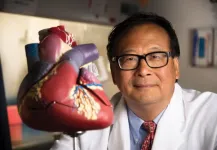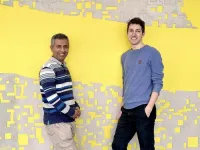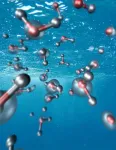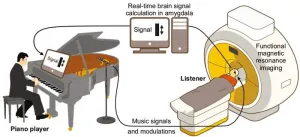(Press-News.org) BIRMINGHAM, Ala. – Just imagine this, the creation of:
An artificially intelligent machine that acts as a human exocortex, a system that will interface with and make an old brain tick normally.
Human cells that can sense metastatic cancer or the boundaries of solid tumors and respond with killing of tumor cells, release of inflammatory payloads or bioluminescence to help guide surgical removal.
Manufactured vaccines that prevent or impede a cancer, block opioid action or reverse autoimmune diseases like multiple sclerosis.
These are a few of the far-reaching ideas put forward by 50 international biomedical engineering experts in a new white paper — “Grand challenges at the interface of engineering and medicine,” published in the IEEE Open Journal of Engineering in Medicine and Biology.
Jianyi “Jay” Zhang, M.D., Ph.D., chair of the Department of Biomedical Engineering and a leader in heart tissue engineering at the University of Alabama at Birmingham, is one of the co-authors who devoted a two-day workshop and months of in-depth discussions to identify five grand challenges as research areas with the greatest potential of achieving tremendous impact on the field of medicine in the next decades or century.
The grand challenges presented in the study are:
A new discipline called “Accumedicine,” through creation of avatars of cells, tissues, organs and whole humans. These can be tissue avatars or digital computer avatars.
Development of smart and responsive devices for human function augmentation.
Exocortical technologies to understand brain function and treat neuropathologies.
Development of approaches to harness the human immune system for health and wellness.
New strategies to engineer genomes and cells.
As the authors write, “The 21st century is witnessing a paradigm shift in human health and medicine. Engineering of entirely unforeseen devices, sensors and technologies have given rise to a deeper understanding of human physiology and pathophysiology. We are in the unprecedented position to translate the knowledge from multiscale myriad measurements into actionable outcomes, and the Grand Challenges outlined here provide a road map for this future.”
“This Grand Challenge paper is an example of both the ‘Convergence Revolution’ in biology and the ‘Fourth Industrial Revolution,’” said Zhang, who helped write and revise the manuscript.
The Convergence Revolution, as outlined in a Massachusetts Institute of Technology white paper in 2011, is where the “tools, methods and concepts and processes of chemistry, physics, engineering, computer science, material sciences and engineering are increasingly used in biological research — and in which, conversely, life scientists’ understanding of complex evolutionary systems is influencing physical science and engineering.”
The Convergence Revolution is the third revolution in biology since the mid-20th century, an MIT timeline reports. The first revolution was molecular and cellular biology, beginning with the 1953 description of the structure of DNA by Watson and Crick. The second revolution was genomics, the drive to study an organism’s entire genome, including DNA sequencing of the entire human genome. The third revolution evolved in the first decade of the 21st century as academic sectors began to explore Convergence, including the 2009 National Academy of Sciences report, “A new biology for the 21st Century.”
“The Grand Challenges paper presents high-level perspectives from leaders in the Convergence Revolution and the Fourth Industrial Revolution, which have impacted and will continue to impact every perspective of society and life,” Zhang said. “I think — and am very hopeful — that new and younger and stronger leaders will emerge naturally as these revolutions continue.”
The Fourth Industrial Revolution, as described by Klaus Schwab, founder of the World Economic Forum, is “a fusion of technologies that is blurring the lines between the physical, digital, and biological spheres,”
Schwab says that the First Industrial Revolution, beginning in 1784, used water and steam power to mechanize production. The Second, beginning in 1870, used electric power to create mass production. The Third, beginning in 1969, used electronics and information technology to automate production.
Notably, the cyber-physical systems of the Fourth are distinct from the Third in velocity, scope and systems impact, Schwab says. “The speed of current breakthroughs has no historical precedent,” Schwab wrote. “When compared with previous industrial revolutions, the Fourth is evolving at an exponential rather than a linear pace. Moreover, it is disrupting almost every industry in every country.”
That includes biomedical research, Zhang says. “UAB — as, evidenced by establishing the new joint Department of Biomedical Engineering in 2015 under the UAB’s School of Engineering and the Marnix E. Heersink School of Medicine — will continue grow strongly as an engaged leader and contributor to the Convergence Revolution and the Fourth Industrial Revolution.”
In the IEEE Open Journal of Engineering in Medicine and Biology Grand Challenges paper, each challenge is framed into five topics to explain the current needs and existing gaps that will help guide future work. The topics are social needs, challenges, enabling technologies, multidisciplinary teams and core competencies.
Each of the five Grand Challenges, the authors say, will need interdisciplinary collaborations between life-science-based and engineering disciplines, as well as next-generation training of doctors and clinicians in technologically and quantitatively driven sciences.
Corresponding authors of the study are Shankar Subramaniam, Ph.D., University of California, San Diego; Paolo Bonato, Ph.D., Harvard Medical School, Boston, Massachusetts; and Michael Miller, Ph.D., Johns Hopkins School of Medicine and Whiting School of Engineering, Baltimore, Maryland.
The IEEE is a community of more than 450,000 technology and engineering professionals and a trusted international voice for engineering, computing and technology. Funding for the study came from the IEEE Engineering in Medicine and Biology Society, Johns Hopkins University and UC San Diego.
At UAB, Zhang holds the T. Michael and Gillian Goodrich Endowed Chair of Engineering Leadership.
END
Five grand challenges for the future at the interface of engineering and medicine
These research areas — part of the Convergence Revolution — have the greatest potential of achieving tremendous impact on the field of medicine in the coming decades or century.
2024-02-26
ELSE PRESS RELEASES FROM THIS DATE:
Australian researcher's journey from kangaroo whisperer to global dance sensation
2024-02-26
Dr Weliton Menário Costa, a PhD graduate from The Australian National University (ANU), has been announced the overall winner of the 2024 global Dance Your PhD contest after wowing judges with his wickedly creative and quirky dance submission, ‘Kangaroo Time (Club Edit)’.
One of the world's leading researchers in kangaroo behaviour, he is the first person from ANU to win the Dance Your PhD competition, and just the fourth person from an Australian institution to do so since its inception in 2008.
Better known as ‘WELI’, the singer-songwriter, creator and biologist weaves together a funky beat, original songwriting, drag queens and Brazilian funk dancers ...
Black carbon sensor could fill massive monitoring gaps
2024-02-26
Black carbon is the most dangerous air pollutant you’ve never heard of. Its two main sources, diesel exhaust and wood smoke from wildfires and household heating, produce ultrafine air particles that are up to 25 times more of a health hazard per unit compared to other types of particulate matter. Despite its danger, black carbon is understudied due to a lack of monitoring equipment. Regulatory-standard sensors are wildly expensive to deploy and maintain, resulting in sparse coverage in regions infamous for poor air quality, such as the greater Salt Lake City metropolitan area in Utah.
A University of Utah-led study found that the AethLabs ...
UC Irvine advances stem cell research with $4 million CIRM grant for shared resources lab
2024-02-26
Irvine, Calif., Feb. 26, 2024 — The University of California, Irvine has received a five-year, $4 million grant from the California Institute for Regenerative Medicine to establish a shared resources lab in the Sue & Bill Gross Stem Cell Research Center. The facility will offer essential technologies and training for the development of novel in vitro stem cell-based modeling that will serve researchers across the campus and the state.
“Stem cells possess the potential to transform into particular cell types, offering promising avenues for rejuvenating and restoring tissues harmed by injury or affected ...
New discovery suggests significant glacial retreat in West Antarctica began in 1940s
2024-02-26
Among the vast expanse of Antarctica lies the Thwaites Glacier, the world’s widest glacier measuring about 80 miles on the western edge of the continent. Despite its size, the massive landform is losing about 50 billion tons of ice more than it is receiving in snowfall, which places it in a precarious position in respect to its stability.
Accelerating ice loss has been observed since the 1970s, but it is unclear when this significant melting initiated – until now. A new study published in the journal PNAS, led by researchers ...
Butterflies mimic each other’s flight behaviour to avoid predators
2024-02-26
Researchers have shown that inedible species of butterfly that mimic each others’ colour patterns have also evolved similar flight behaviours to warn predators and avoid being eaten.
It is well known that many inedible species of butterfly have evolved near identical colour patterns, which act as warning signals to predators so the butterflies avoid being eaten.
Researchers have now shown that these butterflies have not only evolved similar colour patterns, but that they have also evolved similar ...
What math tells us about social dilemmas
2024-02-26
Human coexistence depends on cooperation. Individuals have different motivations and reasons to collaborate, resulting in social dilemmas, such as the well-known prisoner's dilemma. Scientists from the Chatterjee group at the Institute of Science and Technology Austria (ISTA) now present a new mathematical principle that helps to understand the cooperation of individuals with different characteristics. The results, published in PNAS, can be applied to economics or behavioral studies.
A group of neighbors shares a driveway. Following a heavy snowstorm, the entire driveway is covered in snow, requiring clearance for daily activities. ...
Protecting fish doesn’t have to mean neglecting people, study concludes
2024-02-26
BEAUFORT, N.C. –With fish stocks declining globally, more than 190 countries recently made a commitment to protect about a third of the world’s oceans within “Marine Protected Areas,” or MPAs by the year 2030. But these designated areas of the ocean where fishing is either regulated or outright banned can come at a huge cost to some coastal communities, according to a new analysis.
To help prepare for the expansion of MPAs, an international team of researchers from Duke University, Florida State ...
What will it take for China to reach carbon neutrality by 2060?
2024-02-26
To become carbon neutral by 2060, as mandated by President Xi Jinping, China will have to build eight to 10 times more wind and solar power installations than existed in 2022. Reaching carbon neutrality will also require major construction of transmission lines.
China land use policies will also have to be more coordinated and focused on a nation-wide scale rather than be left to ad hoc decisions by local governments. That’s because 80% of solar power and 55% of wind power will have to be built within 100 miles of major population centers.
These are the conclusions of a new study from ...
A new theoretical development clarifies water's electronic structure
2024-02-26
There is no doubt that water is significant. Without it, life would never have begun, let alone continue today – not to mention its role in the environment itself, with oceans covering over 70% of Earth.
But despite its ubiquity, liquid water features some electronic intricacies that have long puzzled scientists in chemistry, physics, and technology. For example, the electron affinity, i.e. the energy stabilization undergone by a free electron when captured by water, has remained poorly characterized from an experimental ...
Live music emotionally moves us more than streamed music
2024-02-26
How does listening to live music affect the emotional center of our brain? A study carried out at the University of Zurich has found that live performances trigger a stronger emotional response than listening to music from a device. Concerts connect performers with their audience, which may also have to with evolutionary factors.
Music can have a strong effect on our emotions. Studies have shown that listening to recorded music stimulates emotional and imaginative processes in our brain. But what happens when we listen to music in a live setting, for example at a music festival, at the opera or a folk concert? ...
LAST 30 PRESS RELEASES:
Pusan National University researchers discover faster, smarter heat treatment for lightweight magnesium metals
China’s 2024 Gastroenterology Report: marked progress in endoscopy quality and disease management
Pusan National University researchers uncover scalable method for ultrahigh-resolution quantum dot displays
Researchers use robotics to find potential new antibiotic among hundreds of metal complexes
Gut bacteria changes at the earliest stages of inflammatory bowel disease
Scientists develop new way to “listen in” on the brain’s hidden language
Brain research: “Pulse generators” grow and shrink as memories are formed
For teens, any cannabis use may have impact on emotional health, academic performance
School meals could unlock major gains for human and planetary health
Menopause hormone therapy does not appear to impact dementia risk
Signature patterns of brain activity may help predict recovery from traumatic brain injury
Dresden study uncovers new key mechanism in cancer cells
New species are now being discovered faster than ever before, study suggests
Cannabis-based products show limited short-term benefit for chronic pain, with increased risk of adverse effects
Cannabis products with more THC slightly reduce pain but cause more side effects
Clearing the brain of aging cells could aid epilepsy and reduce seizures
Brain injuries linked with potential risk of suicide, new study finds
New technique lights up where drugs go in the body, cell by cell
New study finds movement of fishing fleets can reveal shifts in marine ecosystems
Embargoed: New evidence points to potential treatment for vascular dementia
Study uncovers disrupted brain balance in alcohol dependence
Working in groups can help Republicans and Democrats agree on controversial content moderation online
Structural findings reveal how distinct GPCR ligands create different levels of activation
Anything-goes “anyons” may be at the root of surprising quantum experiments
UC review: Maximizing workplace opportunity for veterans
From generation to complex control: Metasurfaces make perfect vortex beams "within reach"
Thin-film lithium niobate-based detector: recent advances and perspectives
Exploring why some people may tend to persistently make bad choices
How cells balance their protein levels
Nirsevimab vs RSVpreF vaccine for RSV–related hospitalization in newborns
[Press-News.org] Five grand challenges for the future at the interface of engineering and medicineThese research areas — part of the Convergence Revolution — have the greatest potential of achieving tremendous impact on the field of medicine in the coming decades or century.








